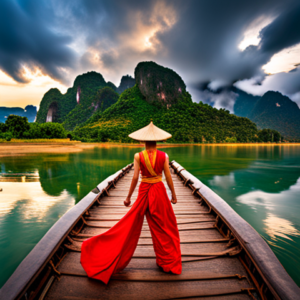Laos, often referred to as the ‘Land of a Thousand Elephants,’ is steeped in a tranquil, almost mystical allure that comes from its rich cultural heritage and unspoiled landscapes. While famous destinations like Luang Prabang and Vientiane draw travelers with their temples and heritage sites, there’s much more to this enigmatic country waiting to be explored. Tucked away from the well-worn tourist trails, the lesser-known cities of Savannakhet and Pakse hold the promise of an authentic and off-the-beaten-path adventure in Laos. This comprehensive guide will walk you through the charm and mystery of these hidden gems, catering to the intrepid souls who long for travel experiences that go beyond the ordinary.
Savannakhet: A Living Legacy
Savannakhet, the largest province in southern Laos, is not just a city—it’s a living testament to a bygone era. Its name, which means ‘Heavenly Savanna,’ speaks to the natural splendor that forms its backdrop. But it’s the echoes of the French colonial past that resonate through its streets, complimenting a Khmer-influenced culture that showcases the city’s multilayered history.
A Tapestry of Traditions
Step into the heart of Savannakhet, and history unfolds before your eyes. The preserved architecture of colonial villas standing proudly alongside age-old Buddhist temples like That Ing Hang stupa illustrates the harmonious blend of East and West that defines the city.
Craftsmanship is a way of life here, with the city renowned for its silk and traditional bronze casting. The Dinosaur Museum and the tumbledown Champassak Provincial Museum offer unique insights into history and paleontology, attesting to Savannakhet’s diverse cultural heritage.
Savoring the Authentic
The delectable cuisine of Savannakhet is known for its bold, spicy flavors, and no visit is complete without a taste of koy pa, a local fish paste. The city’s vibrant markets, like Talat Dong and Talat Kao, are a kaleidoscope of colors and aromas, offering a chance to sample exotic fruits and pungent herbs.
Witnessing the process of silk-weaving by skilled hands or the meticulous casting of elaborate khene musical instruments are experiences that ground you in the living traditions of Savannakhet.
Pakse: Gateway to the South
Pakse, the capital of Champasak Province, is your launchpad for exploring the south of Laos. Situated at the confluence of the Mekong and Sedone rivers, the city exudes a laid-back vibe. But don’t be fooled by its tranquility—Pakse is a gateway to the region’s most breathtaking natural sites.
Into the Wild
Pakse’s main allure is the natural bounty that surrounds it. The Bolaven Plateau, with its mist-covered coffee plantations and picturesque waterfalls, is perfect for trekkers and nature enthusiasts. The awe-inspiring Wat Phou, a UNESCO World Heritage site, is a short ride away, a Khmer temple complex that has stories to tell from a thousand years ago.
Adventure beckons from the depths of the nearby Tad Lo waterfall, where you can bathe in its refreshing waters and watch the majestic elephants roam in their natural habitat at the nearby Tad Fane Elephant Camp.
A Feast for the Senses
Pakse’s culinary offerings are a reflection of its diverse influences—Thai, Vietnamese, and traditional Lao. Indulge in a bowl of kao soy, a hearty noodle soup spiced to perfection, or savor the melt-in-your-mouth texture of mok pa, fish steamed in banana leaves, a local specialty.
At Pakse’s bustling night market, you can browse through stalls of handicrafts, try your hand at bargaining for souvenirs, and savor an array of street food that will tantalize your taste buds.
The Contrasting Allure of Cities
Savannakhet and Pakse, while both steeped in traditional charm, present travelers with differing faces of Laos. Savannakhet is a city where time seems to have stood still, where the languid pace of life encourages you to soak in every moment. On the other hand, Pakse’s proximity to the region’s most iconic natural landmarks and its strategic position as a crossroads of cultures make it a dynamic, adventure-filled destination.
Essential Travel Tips
The allure of Savannakhet and Pakse lies in their authentic experiences, untouched by mass tourism. Here are a few tips to make the most of your travels:
Navigating the Cities
Transport between Savannakhet and Pakse is relatively straightforward via bus or minivan, with the scenic route allowing you to witness the changing landscapes. In both cities, renting a bicycle or motorbike is an excellent way to explore at your own pace.
Hidden Gems and Must-Do Experiences
In Savannakhet, venture to the peaceful banks of the Mekong River for a serene sunset, or take a day trip to the mysterious and majestic ruins of the Vat Phou Temple Complex near Pakse. Don’t miss the chance to partake in the almsgiving tradition at dawn, a humbling experience that connects you with the city’s spiritual fabric.
Cultural Sensitivities and Responsible Tourism
Laotian culture values modesty and respect. When visiting temples in either city, dress appropriately—long pants or skirts, and covered shoulders. The use of respectful language and behavior is greatly appreciated, especially in religious sites and when interacting with locals.
In Conclusion: An Invitation to the Unknown
Savannakhet and Pakse are not just waypoints on a map; they are destinations that promise a deep, enriching experience for those willing to stray from the trodden path. From Savannakhet’s nostalgic whispers to Pakse’s untamed beauty, these cities unravel the authentic tapestry of Laos, offering a glimpse of what once was and what continues to be.
For the traveler who seeks connection over conquest and discovery over sightseeing, these hidden gems are an open invitation to indulge in the true spirit of adventure. Pack your bags, chart a course less traveled, and prepare to be mesmerized by the secrets that await in the heart of Indochina.
